

Philip Rees have been manufacturing respected high-performance, easy-to-use MIDI to CV converters since 1988. The purpose of these devices is to enable the MIDI control of analogue (analog) synthesizers.
![]() Independent product review by Sound on Sound, the world's best music recording magazine.
Independent product review by Sound on Sound, the world's best music recording magazine.
 Little MCV MIDI to CV Converter
Little MCV MIDI to CV ConverterThe Little MCV is an up-to-date high-resolution, high-speed interface unit. It offers great functionality, performance and quality at a low price.
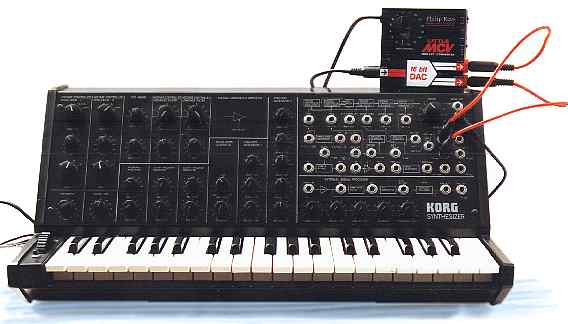
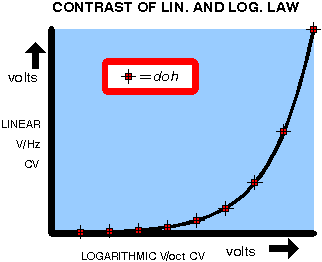 This up-to-date interface midi to cv unit lets you use your MIDI keyboard, computer, sequencer or other MIDI master device to control your irreplaceable old analogue monosynths, with their fat bass sounds and friendly knobs.
This up-to-date interface midi to cv unit lets you use your MIDI keyboard, computer, sequencer or other MIDI master device to control your irreplaceable old analogue monosynths, with their fat bass sounds and friendly knobs.
The Little MCV responds fast and can generate control voltages for the common one-volt-per-octave (logarithmic VCO, as used by Roland and Moog) system and the so-called volts-per-hertz (linear VCO, as used by Korg) system. CV type is selected by a slider. The voltage law of the two types is contrasted in the adjacent graph.
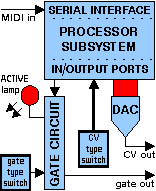 Superb 16 bit resolution
Superb 16 bit resolutionThe use of a high quality, modern 16 bit DAC means that the logarithmic pitch CV output can be perfectly in tune across the full note range, with fine steps (a stunning 512 steps per semitone) for the firmware-implemented pitchbend, pitch vibrato and portamento. 16 bit conversion also lets the Little MCV generate an accurate linear CV of superlative stability over a very wide pitch range.
In V/oct mode, unlike other low cost units, the Little MCV responds properly to pitch over the full 128 semitone MIDI range. The CV output also has a wide range available: from -10V to +20V. A tuning preset adjustment is provided to set the V/oct offset or V/Hz slope. A trim preset lets you finely match your target instrument with respect to the slope for V/oct, or the offset for V/Hz.
The pitchbend firmware can use the full 14-bits of the MIDI pitchbend value. This combines with the 16-bit conversion to give clean stepless glissando if you have a suitable high resolution source of pitch wheel data. The default pitchbend range is plus-or-minus one octave. The standard MIDI 'pitchbend sensitivity' Registered Parameter is observed, so you can alter the bend range if required.
Under MIDI control, the Little MCV digitally generates a precise triangular low frequency oscillator (LFO) signal, which may be added to the CV output - to create a high quality pitch vibrato. The LFO depth is controlled by the product of the MIDI Modulation Wheel and a value derived from the Tremolo Depth Controller (see graph below). The LFO speed is conveniently set by MIDI Non-Registered Parameter Number 00.
The portamento (pitch-to-pitch glide) response is exponential and free of irregularities. The MIDI 'Portamento On/Off and Portamento Time messages are observed.
The table below lists the MIDI controller (Control Change) numbers used in Little MCV, and summarises what they do.
| Dec | Hex | MIDI Controller Name | Usage in Little MCV |
| 1 | 01H | Modulation Wheel MSB | Coarse setting of LFO depth |
| 5 | 05H | Portamento Time MSB | Coarse setting of pitch glide speed |
| 6 | 06H | Data Entry MSB | Coarse setting of LFO speed and bend range |
| 33 | 21H | Modulation Wheel LSB | Fine setting of LFO depth |
| 37 | 25H | Portamento Time LSB | Fine setting of pitch glide speed |
| 38 | 26H | Data Entry LSB | Fine setting of LFO speed and bend range |
| 64 | 40H | Damper pedal (sustain) | Sustains all subsequently released notes |
| 65 | 41H | Portamento On/Off | Enables and disables pitch glide function |
| 66 | 42H | Sostenuto | Sustains only subsequently keyed notes |
| 68 | 44H | Legato Footswitch | Selects gate logic for overlapping notes |
| 69 | 45H | Hold 2 | Switches background hold feature |
| 80 | 50H | General Purpose #5 | Selects highest-note or last-note priority |
| 81 | 51H | General Purpose #6 | Enables and disables LFO synchronisation |
| 92 | 5CH | Tremolo depth | Sets LFO depth gain parameter |
| 96 | 60H | Data Increment | Step setting of LFO speed and pitchbend range |
| 97 | 61H | Data Decrement | Step setting of LFO speed and pitchbend range |
| 98 | 62H | Non-Regd Param LSB | Set to zero when setting LFO speed parameter |
| 99 | 63H | Non-Regd Param MSB | Set to zero when setting LFO speed parameter |
| 100 | 64H | Registered Param LSB | Set to zero when setting bend range parameter |
| 101 | 65H | Registered Param MSB | Set to zero when setting bend range parameter |
| 120 | 78H | All Sounds Off | Cancels Hold and clears all keyed notes |
| 121 | 79H | Reset All Controllers | Clears pitchbend and all Control Change values |
| 123 | 7BH | All Notes Off | Clears keyed notes but does not override hold |
| 124 | 7CH | Omni Mode Off | Unit will respond only to selected MIDI channel |
| 125 | 7DH | Omni Mode On | Unit will respond to any MIDI channel |
| 126 | 7EH | Poly Mode Off | Clears keyed notes but does not override hold |
| 127 | 7FH | Poly Mode On | Clears keyed notes but does not override hold |
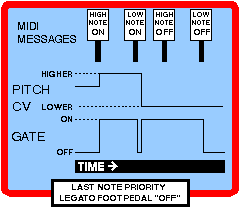 The default trigger mode is multiple for legato playing, but you can change this via the Legato Footswitch MIDI message.
The default trigger mode is multiple for legato playing, but you can change this via the Legato Footswitch MIDI message.
Little MCV also defaults to last note priority, but overlapped notes are not lost, and hidden notes can restart when a more recent note is released - this is generally the most favoured algorithm. MIDI Controller Number 80 will switch over to highest note priority.
The three MIDI Sostenuto, Sustain and Hold 2 commands are all fully implemented.
A simple slide switch lets you choose between 5V positive, 10V positive and S-trig (negative current gate, Moog style) for the gate output.
The ACTIVE lamp indicates when the gate signal is asserted.
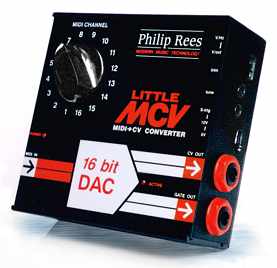 Great package
Great packageYou can easily set your Little MCV to receive on any of the sixteen MIDI channels using the straightforward front panel rotary control.
The Little MCV has a MIDI In DIN socket. The CV OUT and GATE OUT connections are standard quarter-inch jack sockets.
The case of the Little MCV midi to cv is 109mm x 109mm x 40mm.
A 50/60Hz mains (ac) power supply is built-in, obviating the need for an external adaptor. Versions are manufactured for 110 - 120 Vac or 230 Vac – simply specify when ordering. The integral mains lead comes with a plug – please state your plug-type requirement when ordering. You can tell when the unit is powered-up as a power indicator lamp is provided. Power consumption is very low.
This product has been discontinued.
![]() The Little MCV info on this page is also available as an .pdf file.
The Little MCV info on this page is also available as an .pdf file.
![]() to Phil Rees Music Tech home page
to Phil Rees Music Tech home page
![]() to Phil Rees product descriptions
to Phil Rees product descriptions![]() Independent product review by Sound on Sound, the world's best music recording magazine.
Independent product review by Sound on Sound, the world's best music recording magazine.